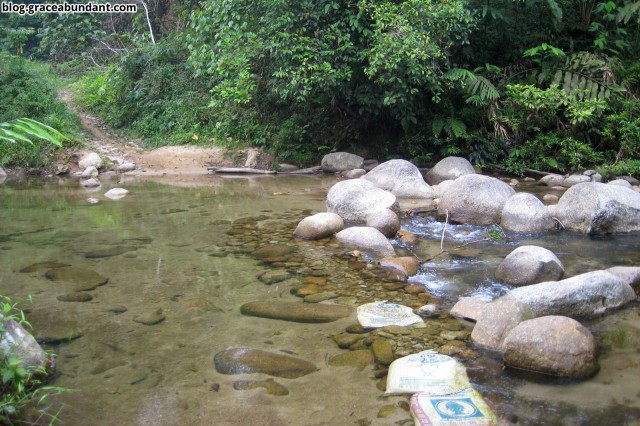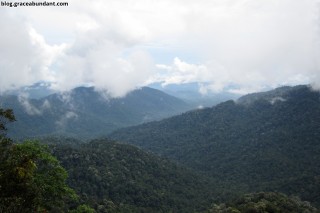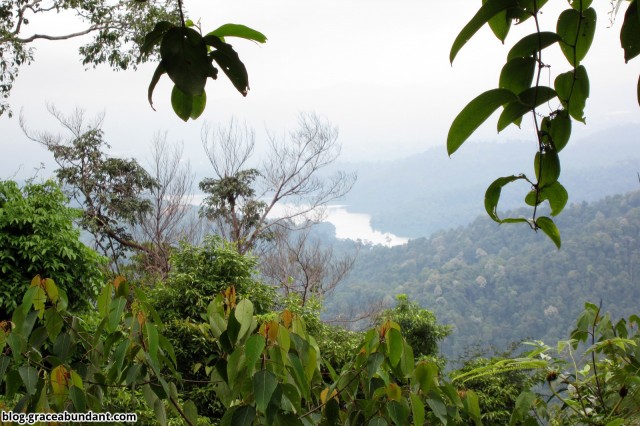DISCLAIMER: This post was written in 2012. Information may be out of date!
Location: Kuala Kubu Bharu, Selangor, Malaysia.
Start point: 3.572510N, 101.738128E 289m a.s.l.
Summit: 3.543263N, 101.719998E 1092m a.s.l.
Difficulty: Moderate. No technical skills required, just a fair amount of stamina. The trail is not very steep, but it goes on for a fair amount of distance. Trail is easy to follow but has a fair number of obstacles (branches, fallen trees, etc.)
Date climbed: Fri 26 Oct 2012
This post is more of an addition to my first post on Bukit Kutu, to provide more thorough information on the Bukit Kutu climbing experience. I decided to revisit Bukit Kutu for a few reasons – a few of my friends wanted to climb it, I wanted to collect a bit more detailed information on the trail for a future climb, and also for the purpose of training (I decided to carry a 12kg backpack up).
As such, I’ll be starting with the GPS details
Download GPX, KMZ (Google Earth)
View on EveryTrail (interactive map)
Duration: 3 hours 57 minutes (including break at summit & ruins)
Length: 6.5km
Average Speed: 1.6km/h
Max elevation: 1092m
Min elevation: 285m
Vertical Up: 992m
Vertical Down: 216m
Times given are for a 3 hour ascent time.
Driving to Bukit Kutu
Assuming you know how to reach Kuala Kubu Bharu (either via Bukit Beruntung, my preferred choice, or Rawang, which is slightly cheaper), keep driving towards Fraser’s Hill. Soon the Sungai Selangor dam will be in sight. A few minutes after passing by a small rest area, turn right into Kampung Pertak. On reaching a small T-junction, turn right. Continue all the way until the road becomes a gravel road, and eventually you’ll reach the 1st bridge. There is some amount of space to park around here, though probably not for more than 5 cars (If not you’ll have to park further back along the road and walk further).
At this point, one can also go down to the river, which is also a great spot to freshen up once you return from climbing Bukit Kutu.
1. [00Hr:00Min, 0km (horizontal), 289m (altitude)] Bridge #1
The bridge crosses over a small stream. The stream can also be crossed without the bridge to the left, where offroad vehicles should also be able to cross, if needed (about ankle deep).
After crossing, follow the fairly wide path for a few minutes. (There are some good views of the river along the path)

2. [00:07, 0.5km, 300m] Bridge #2 (Broken)
This second river is a bit wider and deeper than the first. The bridge has also been broken for quite a long time, but it’s still fairly easy to cross.
3. [00:11, 0.6km, 306m] Junction #1
Keep right. Going left will eventually lead to 2 waterfalls via a 3hr hike.
4. [00:14, 0.8km, 325m] Junction #2
Keep right. The trail will start to narrow after this.
5. [00:18, 1.1km, 311m] River crossing

This is the one major river crossing you’ll have to make. On average, it is just below knee depth, probably between 1-2 feet deep. On my 1st trip, water was completely clear and not that deep. On this 2nd trip, water was about 8″/20cm higher and very slightly cloudy, just over knee deep. Removal of footwear is necessary.
BEWARE: This river can rise to fairly deep levels (estimated chest deep by checking erosion levels) and fairly strong currents, if there is heavy rainfall. When crossing, always face upstream and be aware of any changes in levels especially if it looks like it may be raining upstream. Don’t cross if water level is approaching waist depth or water is turning murky. Always be prepared to wait for levels to recede, it’s not worth risking your life.
6. [00:27, 1.1km, 320m] Stream #1
Comes almost immediately after the river crossing. About 2-4in deep. Unless river levels are high, doesn’t require removal of footwear. On both occasions we got across without removal of footwear.
7. [00:33, 1.2km, 344m] Junction #3
Keep right.
8. [00:37, 1.4km, 333m] Stream #2
Similar to stream #1, about 2-4in deep, and can be crossed easily enough.
9. [00:43, 1.6km 324m] Stream #3
Similar to stream #1, about 2-4in deep, and can be crossed easily enough.
After these junctions and river/stream crossings, the rest of the climb is straightforward. There are a few various paths, but they mostly lead back to the same place. Just watch out for the trail markers or “do-not-cross” markings.
10. [01:00, 2.4km, 419m] Tree shelter

A fairly recognizable checkpoint – a tree with a massive root system across the path. After this tree, the trail stars to climb a bit more steeply.
11. [01:06, 2.5km, 460m] Clearing
One of the few open places along the trail. Probably one of the few places you could camp if necessary.
12. [01:28, 3km, 602m] “Keep right” before CP4
Optional and obvious, as the left path rejoins the trail, but consists of a very steep climb. If you’re adventurous, you can go left. Otherwise, one would naturally take the easier right path.
13. [01:33, 3.2km, 643m] Checkpoint 4, water point

The only water point along the way to the summit. Don’t drink without treatment.
14. [01:36, 3.3km, 666m] “Turn left, go up”
Fairly obvious. If I remember, there’s a tape across the right path preventing people from going the wrong way. If in doubt, the left trail has trail markers (ribbons tied to the trees)
15. [01:40, 3.4km, 670m] “Keep left while descending”
I’m fairly sure that the right path rejoins the main trail, but there was an “X” marked by sticks across the right trail (as seen when descending). Clear in the daytime, but may be missed in darkness.
16. [01:55, 3.9km, 764m] Checkpoint 5, huge boulder
(My GPS signal went a bit wonky here due to the huge boulder) This checkpoint can’t be missed. Take a good break here and snap some photos. Be aware that there are some sweat bees around which may take a liking to your perspiration, but as long as you don’t squash/swat them, they won’t sting you.
The section of trail for 10 minutes after CP5 is fairly slippery, so take care. There is a small cord tied there to assist, but don’t put your full weight on it. Instead, try to find the best places to put your feet and only rely on the rope for extra stability.
Also, between CP5 and the summit, there are a few sections which require squatting down to pass under fallen bamboo. Be prepared to get your hands muddy if the ground is muddy!
17. [02:44, 5.5km, 926m] “Turn left and go up”
There was tape across the right path. Fairly clear.
18. [03:05, 6.1km, 1074m] Broken house
Just before the broken house (when you can see the chimney), when you emerge from the jungle, there’s an intersection where a well is placed. Turning left goes towards the house. Going straight goes on towards the summit.
Note: The broken house area has a few exits! I’m not sure where they go, so remember to take the exit which passes by the well.
19. [03:09, 6.1km, 1092m] Summit
After climbing up a few paths with wooden branch handrails, there are a series of ladders which reach the viewing point, which is the summit. Beware of a potential wasps nest on the first rock, on which the 1st ladder rests. There are a few holes in the rocks which used to hold a wasps nest. (It was active on my first climb, though I didn’t see any wasps there on my 2nd climb) Remember the rule of ONE person on a ladder at a time. You can probably only fit 4 people MAX on the summit at a time.

20. [+00:16, +0.4km, 1062m] Ruins
At the bottom of the boulders which lead to the viewing point, next to where the above [summit marker] photo was taken, there’s a trail which continues on to some abandoned ruins. The journey takes about 15 minutes each way. Just follow the trail markers, it should be fairly clear.
At the ruins, turn back the way you came from. (I believe the trail continues on all the way down to Kuala Kubu Bharu, which some people have taken before)
Preparation
Notes
- Poor/no phone coverage.
- There are shallow river crossings (3 streams, 1 river knee deep). You’ll probably want to take off shoes to cross the river. Bring something to keep electronics/etc. dry.
- In case of bad weather, injuries, etc., always be prepared for potential delays.
- Petrol costs ~RM30-35 per car, RM10.80 [RM5.40 each way] toll from PJ (Damansara)
- It’s the rainy season, be ready for rain and cold weather. I suggest packing an extra singlet or T-shirt to wear over in case.
- Be prepared for leeches!
Essential Items
- Minimum 2L fluid (3L+ recommended), isotonic recommended.
- High energy snacks/lunch
- Hiking shoes (good grip)
- Raincoat/poncho
- Plastic/waterproof bags for electronics in case of rain
- Emergency gear: Whistle & small flashlight/headlamp
To leave in car
- Extra drinking water (1L)
- Change of clothes/towel
- 2 large plastic bags, one for dirty shoes, one for dirty clothes
- Clean slippers/sandals
Recommended Items
- Tissue paper
- Insect repellent
- Hiking stick
- Extra T-shirt
- Salt (for isotonic drinks / leeches / etc.)
- Wristwatch
- Small hand towel
- Cap/Hat for summit, if it is sunny
- Emergency Gear: Knife, fire starting kit, 1st aid kit, rope/cord, etc.
(See my personal packing list here)
















































